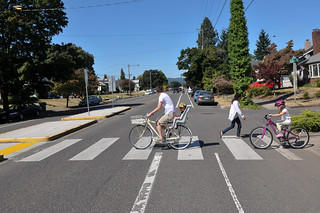Portland has a long way to go, but it’s one of the country’s best cities to bike in. Sad to say, it isn’t yet one of the country’s best cities to walk in.
So why do so many people, here and elsewhere, speak as if there’s an activity called “bikingandwalking” that can be encouraged all at once?
Some new research from a recent Portland State University engineering grad helps to disentangle the science of these two awesome activities.
“Highly walkable and highly bikeable environments are quite different,” writes Christopher Muhs (who’s now a transportation engineering assistant at local firm DKS) in his paper. “Two of the most divergent characteristics are travel speeds and distances. … It follows that pedestrians tend to travel much shorter distances than cyclists.”
Muhs, working with PSU professor Kelly Clifton, looked at various studies that found correlations between characteristics of cities and neighborhoods and the amount of biking and walking that happens in them — number of intersections per mile, for example, or the size in square feet of local retail stores. Here’s one interesting discovery:
The magnitudes of the impact of built environment variables on walking are often much larger than those with bicycling. This is also true of trip distance or travel time variables. In three US studies, the magnitudes of the trip distance coefficient for walk mode choice were more than three times those of the corresponding coefficient for bicycling.
In other words: it takes a lot longer to rebuild a city into walk-friendliness than it does to rebuild it into bike-friendliness.
Advertisement
Here’s another insight: it might be possible for a city to be too dense for biking.
Cycling may also be sensitive to minimum and maximum thresholds. For example, high-density locations correlated with central business districts, downtowns, and regional centers may not provide environments conducive to cycling. The greater intersection densities and traffic control often mean more stops, slowing travel speeds. … On the other end of the spectrum, low-density environments may not provide destinations within a reasonable distance for utilitarian cycling but may offer better recreational opportunities.
Muhs also touches on this perennial problem:
It has also been acknowledged that cyclists may be more multimodal than other travelers, due to weather or other situational constraints. … Nearly all of the literature we reviewed consisted of cross-sectional studies, with individuals observed at just one point in time. The lack of longitudinal studies on bicycling makes us raise the question: Is our current understanding of cycling behavior based on a slim percentage of the overall cycling population?
Yes indeed.
The paper from Muhs and Clifton was published this fall in the Journal of Transportation and Land Use.
— Michael Andersen, (503) 333-7824 – michael@bikeportland.org



